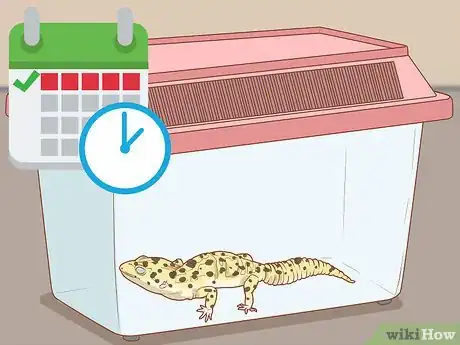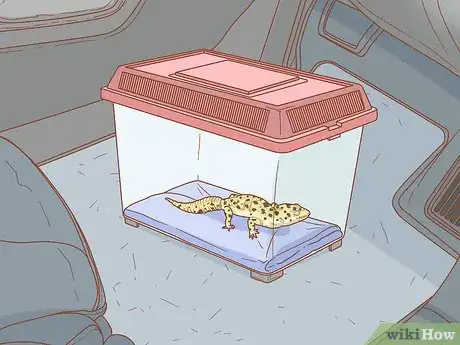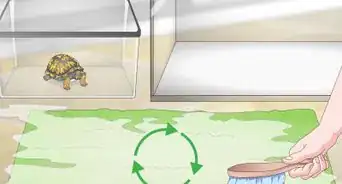This article was co-authored by wikiHow Staff. Our trained team of editors and researchers validate articles for accuracy and comprehensiveness. wikiHow's Content Management Team carefully monitors the work from our editorial staff to ensure that each article is backed by trusted research and meets our high quality standards.
This article has been viewed 38,297 times.
Learn more...
Moving with a reptile can seem like a daunting task. However, with the proper preparation and method of transportation, the move will be a breeze. Check local laws for where you are moving to make sure all is in order with your reptile, get it checked out by a vet before you move, and prepare the proper carrier for transport. Take the reptile with you in a car for the least stressful move, or send it by air or with a pet transportation company if you can’t drive it yourself.
Steps
Getting Ready to Move and Packing Your Reptile
-
1Check the local laws to make sure you can bring your reptile. Different cities, states, and countries have different rules for the importation of reptiles. Check online for any special requirements before you move.[1]
- It's a good idea to do this as soon as you start planning your move in case you need to get any special documentation to move your reptile with you.
-
2Get your reptile checked by a vet no more than 10 days before moving. Get the vet to sign a health certificate for your reptile no more than 10 days before you move so you have up-to-date health info. Ask your vet for any special advice about moving with the specific type of reptile you own.[2]
- Now is also a good time to look online for a local exotic pet vet where you are moving to; in case you need to take your reptile for a checkup when you arrive.
Advertisement -
3Buy a reptile carrying container to transport your reptile in. The container needs to be big enough that the reptile can move around inside, but not so big that it could get thrown around during transportation. Make sure the container is unbreakable and has small air holes for ventilation.[3]
- Keep in mind that venomous reptiles have to be placed inside 2 containers. Non-venomous reptiles can be transported in just 1 container.
- If your reptile requires a moist environment, you should get a waterproof carrying container so you can line the bottom with wet towels.
- You can adapt any kind of sealable plastic container to transport your reptile by punching air holes in it. For large reptiles, like iguanas, a plastic dog or cat carrier can work.
-
4Put your reptile in the carrier for a few hours each day the week before the move. This will give your reptile time to get used to it before they get transported. They will be less frightened on the day of the move if they are used to the carrying container.[4]
- Keep the rest of your reptile’s routine the same so that they don’t get stressed out before it’s time to move.
-
5Pack your reptile into the carrier with towels on moving day. Line the bottom of the carrier with wet towels if the reptile needs a moist environment, or dry towels if it doesn’t. This will also provide some extra cushioning for transportation.[5]
- Don’t place any extra objects like rocks or sticks in the carrier; even if you may be tempted to try to make it more like home for your reptile. They could move around during transportation and hurt your reptile.
-
6Label the reptile carrier if you are going to ship it with an airline. Mark the container on all sides with your contact information. Place large warning labels that say: “live animal” and “this side up”.
- This will ensure that anyone who handles the carrier takes extra care with it and places it the correct side up so that your reptile gets safely transported.
Transporting Your Reptile by Land or Air
-
1Take your reptile with you by car if possible. This is the least stressful and most comfortable way for your reptile to move to your new home. Make sure to secure the carrier in the backseat with the seat belt, or place in on the floor, so it won't move around or fall over.[6]
- Taking your reptile in a car means you will be able to control variables like temperature and noise.
- Keep the reptile’s carrier out of direct sunlight and any items that could accidentally fall on it while you drive.
- Try to keep stops to a minimum to make the trip as short as possible for your reptile. Carry extra food and water with you in case you get delayed or anything unexpected happens.
-
2Transport your reptile via an airline if you cannot take it by car. Airlines will transport most kinds of reptiles as cargo. Check with airlines before you book flights to confirm that they can ship your reptile with you and ask about any special requirements.[7]
- Try to book the shortest flights possible to reduce the amount of time your reptile will be traveling.
-
3Use a pet transportation service as an alternative to driving or air transport. Moving companies aren’t allowed to transport pets. Search for a pet transportation service that can transport your reptile to your new home for you if you won’t be able to drive it yourself or don’t want to send it with an airline.[8]
- Many pet transportation services handle everything from picking the reptile up and packing it, to delivering it to your new home. This is a good alternative if you want to leave it to the professionals.
-
4Settle your reptile into its normal habitat as soon as it arrives at your new home. Set up the habitat in a quiet area and set the correct temperature in the room. Adhere to your reptile’s normal feeding schedule and routine to reduce the stress of the change.[9]
- It’s normal for reptiles to stop eating or act strangely after a move. If odd behavior or refusal to eat continues for more than 1 week after the move, then consult with a vet.
Community Q&A
-
QuestionWhat if we're moving but we're taking everything on a bus? Can I take my pet?
 Community AnswerIt's possible, but you should talk to the bus operator.
Community AnswerIt's possible, but you should talk to the bus operator. -
QuestionI'm traveling with my beardie who is a year old and almost 2 feet long, and we're traveling an hour in a small car. What should I do?
 Animal Expert101Community AnswerI suggest bringing your bearded dragon in its tank, but if there is not enough room, then use a dog carrier. Since it's only an hour, your beardie should be fine.
Animal Expert101Community AnswerI suggest bringing your bearded dragon in its tank, but if there is not enough room, then use a dog carrier. Since it's only an hour, your beardie should be fine. -
QuestionWhat would be involved in preparation for a van to carry various reptiles?
 Community AnswerThe van should have space for cages and a system in place to ensure they do not move during transport. The van should also have a climate control system to ensure the reptiles are kept at the proper temperature.
Community AnswerThe van should have space for cages and a system in place to ensure they do not move during transport. The van should also have a climate control system to ensure the reptiles are kept at the proper temperature.
References
- ↑ https://www.moving.com/tips/moving-with-reptiles/
- ↑ https://www.moving.com/tips/moving-with-reptiles/
- ↑ https://www.petplace.com/article/reptiles/general/suggestions-for-safely-transporting-your-reptile/
- ↑ https://www.mymovingreviews.com/move/moving-exotic-pets/
- ↑ https://www.mymovingreviews.com/move/moving-exotic-pets/
- ↑ https://www.mymovingreviews.com/move/moving-exotic-pets/
- ↑ https://www.moving.com/tips/moving-with-reptiles/
- ↑ https://www.moving.com/tips/moving-with-reptiles/
- ↑ https://www.mymovingreviews.com/move/moving-exotic-pets/

































































